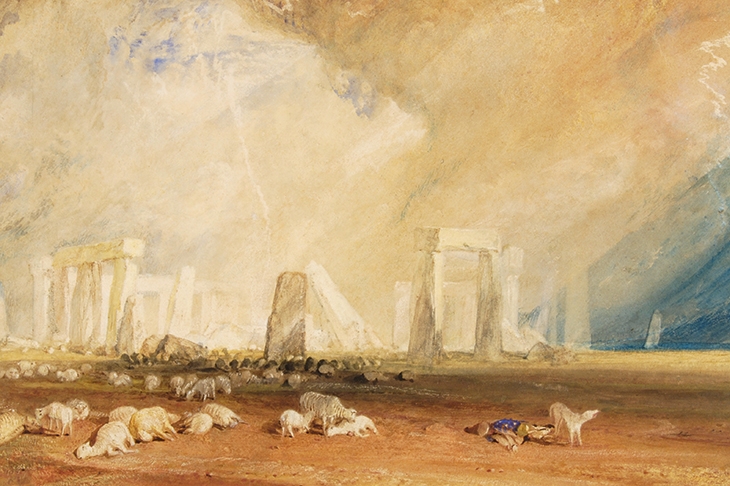If Britain’s prehistoric monuments have had a magnetic attraction for generations of artists, it is perhaps because they have long been seen as works of art themselves. ‘The whole temple of Avebury may be consider’d as a picture’, enthused the antiquary William Stukeley in 1743, while ‘my God how sculptural’ was Barbara Hepworth’s response to Cornish sites such as the Mên-an-Tol and the Nine Maidens which she encountered after moving to St Ives in 1939. The creative tension between artists and these mysterious presences in the landscape is the subject of Sam Smiles’s engaging book British Art: Ancient Landscapes, published to accompany an exhibition at the Salisbury Museum (until 3 September).
Taking us on a tour of sites, albeit one in which we repeatedly find ourselves back at Stonehenge, Smiles demonstrates how all artists reinvent ancient monuments. Some, he tells us, do it more audaciously than others: oddly, it is in a drawing purporting to be a sober work of documentation that we see the most outlandish results of imaginative engagement. Stukeley’s theory that Avebury had been a Druidic temple got the better of his judgment; manipulating the landscape to fit his notion of serpentine avenues he made the complex appear ‘more snake-like than his own surveys had revealed’.
It wasn’t long before megalithic structures began to feature in ambitious paintings teeming with bards and druids, but in the late 18th century they were regarded as portable feasts. Would the grandeur of Stonehenge, wondered Thomas Jones, be lessened if it were found ‘amidst high rocks, lofty mountains and hanging Woods?’ As Smiles wryly observes, he answers his own question with ‘The Bard’ of 1774, a stagey composition in which the relocated standing stones become a diminutive chorus line, dwarfed by huge blasted trees and rocky outcrops.
But it was the Romantics, Smiles tells us, who first embraced Stonehenge. And if they did not play as fast and loose with the appearance of the megaliths as their immediate predecessors, they compensated with theatrical weather conditions. John Constable dismissed plain topographical views of Stonehenge — ‘Its literal representation as a “stone quarry” has been often enough done’ — and proposed a ‘poetical’ one instead. His resulting watercolour, based on a tiny, meticulous pencil sketch done years before, is dominated by an exhilarating weather-drama taking place in the sky. From a safe distance, J. M. W. Turner depicts the same scene littered with the bodies of a shepherd and his flock, victims of an electrical storm that is turning the sarsens into incandescent torches.
Smiles points out that few Victorians tackled such subjects, but that with the return of the Romantic spirit in the early 20th century standing stones and hill figures again loomed large, this time in the imaginations of Hepworth, John Piper, Paul Nash and Eric Ravilious, all of whom were attuned to a mysterious lifeforce simmering away in ancient sites.
This renewed interest happened to coincide with a period of serious archaeological research, resulting in some friction between artists and experts. Smiles quotes Piper imagining himself being ticked off for his ‘drunk and disorderly’ artistic response to the atmosphere of Stonehenge, while in 1927, Nash, for whom the sarsens were genii loci, crossly proposed that anyone ‘airing archiological [sic] small talk should be fined five shillings and hustled into the highway with the utmost ignominy conceivable’.
This beautifully illustrated book allows us to catch artists in the act of negotiating ancient monuments. For his advertising poster for Shell, Edward McKnight Kauffer pulls up in his car, shining his headlights on the Stonehenge sarsens, and Henry Moore, making a series of lithographs in 1973, gets so close that they block out the light. And while Ithell Colquhoun brought various Cornish standing stones together in her imagination for one supercharged painting, Richard Long coolly photographed them in passing; it was his walk, he maintained, that was the primary work of art.
By the time Smiles brings us to Jeremy Deller, the artist’s work ‘Sacrilege’ — the bouncy-castle Stonehenge that went on tour as part of the 2012 Cultural Olympiad — seems not so sacrilegious after all, but rather part of an ongoing tradition of artists’ re-imaginings in which taking liberties is standard.






Comments